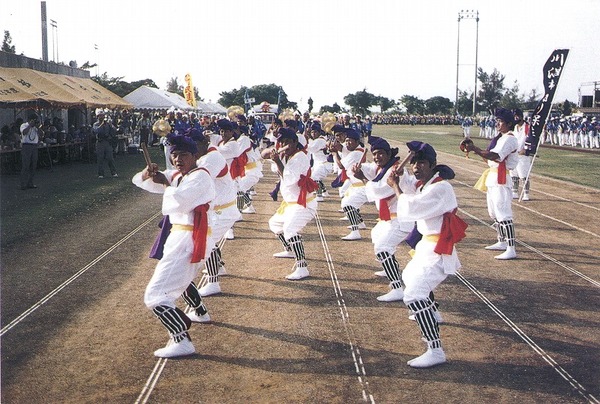トップ > 市の組織 > 教育委員会 > 生涯学習部 > 生涯学習振興課 > 【市指定:無形民俗】川満の棒踊り
【市指定:無形民俗】川満の棒踊り
〔かわみつのぼうおどり〕
川満に伝わる厄払いの踊りで島言葉では「ぼう・っふ」と呼んでいる。
伝えによる踊りの由来は、1686年頃、川満村に「プーキ」(疫病)が大きく流行し、村人達が次から次へと死んでいった。そのため各家庭では悲しみに明け暮れる毎日が続いていた。これを憂いた村の役人達が神に伺いを立ると、その結果、「全すべて部の御嶽に願をかけよ」とのお告げが出た。村の人達は全員集まって、手に手に棒を持ち、鐘を打ち鳴らし、願い事を唱えながら御嶽から御嶽へと廻った。その時、列の後方にいた老婆が「このマムヌやろう」と叫び声をあげた。しかし、村人達には何も見えない。村人達が「何かあったのか」と老婆に尋ねると、老婆は「マムヌが舌を出して嘲り笑っている。 プーキはこのマムヌの仕業だ」と言った。
そこで、村人達は、老婆の指示に従って「マムヌ」を取り囲み、それぞれ持っていた棒でめった打ちにして退治した。その後は、プーキ(疫病)も下火になり、人々は安心して暮らすことが出来た。
村人は、御嶽の神に感謝して、村の繁栄と人々の無病息災を祈って棒踊りを奉納した。棒踊りは、2人棒、3人棒、5人棒、10人棒があったと伝えられる。
今日、その全すべて部を知る人はいない。現在は2人棒と5人棒が踊り継がれている。なお、1686年は、宮古全島を荒らしまわっていた与那覇原軍によって四散していた浦島や川満原、ミヌズマなど川満の古い村々の生き残りを川満原跡に集めて新しい川満の村立てがなされた年と一致する。このことは、川満の棒踊りのはじまりを考える上で興味深い。
【Designated by the City:Intangible Folk】Stick Dance of Kawamitsu
The dance to drive out evil spirits handed down in Kawamitsu is called “bohhu” in the local dialect.
The origin of the dance is said to be around 1686, when a severe epidemic broke out in Kawamitsu Village and the people died one after another. Every household was in deep grief for days. Village officials were concerned about the situation and asked their god what to do. Then, they heard an oracle that they should offer prayers at all the Utaki or sacred sites in the village. All the villagers gathered together and went around to all the Utaki with everybody holding a stick in hand, ringing the bell, and chanting their wishes.
Suddenly an old woman in the back of the crowd screamed, “Damn, this evil spirit!” The rest of the villagers, however, were not able to see anything. They asked the woman what had happened. She said, “An evil spirit is sticking out his tongue and sneering. The epidemic is all his fault!” Following her directions, the villagers surrounded the demon and drove it away by hitting it hard with the sticks that they held. After this, the epidemic subdued and people lived in peace. The residents thanked the god of the Utaki, and dedicated the stick dance, wishing for the prosperity of the village and good health of the community.
Although the stick dance apparently had variations by the number of men and sticks: two, three, five, and ten, nobody knows all the variations today. Two men and sticks, and five men and sticks dances have been handed down to the present time.
When we think of the origin of the stick dance of Kawamitsu, it is intriguing to know that the year 1686 coincides with the year when the new Kawamitsu Village was established in the former Kawamitsubara, gathering former villagers who had lived in Urashima, Kawamitsubara, and Minuzuma, etc. and scattered to elsewhere after surviving the attacks by the Yunababaru forces that rampaged all over the Miyako Islands at that time.
【市指定:無形民俗】川滿的棍棒舞
川滿的棍棒舞是流傳在川滿的消災解難之舞,島上的方言叫作「Bo・fu」。
傳聞該舞蹈的由來是在1686年左右,川滿村大肆流行瘟疫,村民們接連不斷死去。失去親人的家庭每天都沉浸在悲痛之中。村裡的幹部們對這種狀況深感憂慮,於是向神靈尋求解決方法,得到的回答是「向所有的御嶽許願」。就這樣,全體村民聚集起來,每人手裡拿著棍棒,敲打著鐘鼓,口裡許願,從一個御嶽走到另一個御嶽。就在那時,隊伍後方的一位老婆婆突然叫道:「麻木奴你這傢伙!」。可是,其他村民什麽也沒看到。村民問她發生了什麽事,老婆婆説道:「麻木奴伸出舌頭在嘲笑我們,瘟疫就是這傢伙散播的」。
於是,村民們按照老婆婆的指示圍住「麻木奴」,用棍棒亂打將其打退。不久,瘟疫也漸漸消退,人們過上了安心的生活。
村民們感謝御嶽的神靈,表演棍棒舞來祈求村落的繁榮和村民的健康。據說,棍棒舞分2人棒、3人棒、5人棒和10人棒。
今天已經沒有人知道所有的舞蹈。流傳到現在的只有2人棒和5人棒。於是,村民們按照老婆婆的指示圍住「麻木奴」,用棍棒亂打將其打退。不久,瘟疫也漸漸消退,人們過上了安心的生活。村民們感謝御嶽的神靈,表演棍棒舞來祈求村落的繁榮和村民的健康。據說,棍棒舞分2人棒、3人棒、5人棒和10人棒。今天已經沒有人知道所有的舞蹈。流傳到現在的只有2人棒和5人棒。
【미야코지마시 지정:무형 민속】가와미쓰 봉춤
가와미쓰에 전래되는 액땜 춤으로, 미야코 섬의 말로는 “보웃후”라고 한다.
춤의 유래는 다음과 같다. 1686년경, 가와미쓰 마을에 “푸키”(역병)가 크게 유행하여, 마을 주민들이 차례차례로 죽어 갔다. 각 가정에서는 슬픔으로 세월을 보내는 나날이 계속되었다. 이를 우려했던 마을 관리들이 신에게 그 대책을 물어 보았더니, “마을의 모든 우타키에서 기도를 올리라”는 계시가 전해졌다고 한다. 마을 주민들은 모두 모여, 손에 봉을 들고 종을 울리며 기도하면서 전체 우타키를 찾아 다녔다. 그 때, 뒷 열에 있던 한 노파가 “이 마무누 새끼”라고 소리쳤다. 하지만 함께 있던 마을 주민들은 아무 것도 보지못했다. 주민들이 “무슨 일이냐”고 노파에게 물으니 “마무누가 혀를 내밀고 비웃고 있어. 푸키는 마무누가 한 짓이야”라고 말했다고 한다. 그래서 주민들은 노파의 지시에 따라 “마무누”를 둘러싸고 각자가 들고 있던 막대기로 마구내리쳐 퇴치했다고 한다. 그 후 푸키(역병)가 사라지고 사람들은 안심하고 살 수가 있었다. 주민들은 우타키 신에게 감사, 마을의 번영과 무병장수를 기원하며 봉춤을 봉납했다.
봉춤은, 2인, 3인, 5인, 10인 춤이 있었다고 한다. 오늘날, 전부를 알고 있는 사람은 없다. 현재는 2인 봉춤과 5인 봉춤이 계승되고 있다.
또한1686년은 미야코섬 전체를 휩쓸었던 유나바바루군軍에 의해 흩어져 있던 우라시마, 가와미쓰바라, 미누즈마 등 가와미쓰의 오래된 각 마을의 생존자를 가와미쓰바루 유적지에 집합시켜 새로운 가와미쓰 마을을 세운 해이기도 하다. 이것은 가와미쓰 봉춤의 시작을 고찰하는데 의미있는 일이다.
生涯学習部 生涯学習振興課
電話:0980-72-3764






